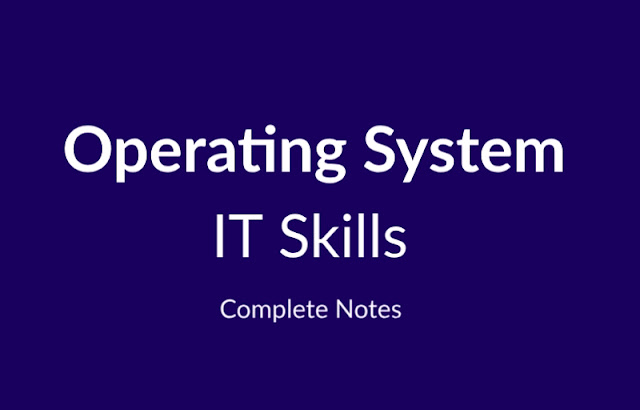OPERATING SYSTEM Notes
Intro:
An operating system is a set of programs that manages all computer components and operations. OS provides an environment in which other programs can be executed and the computer system can be used effectively. An operating system must be installed on every computer. A computer cannot do anything without operating system. When computer is turned on, the OS runs & checks that all parts of computer are functioning properly.

Definition:
“An operating system is a program that acts as an interface between the user and the computer hardware and controls the execution of all kinds of programs”.
“OS is a master program that helps user to interact with computer hardware”.
Features of Operating System (OS)
Interface between the user and the hardware : An OS provides an interface between user and machine. This interface can be a graphical user interface (GUI) in which users click onscreen elements to interact with the OS or a command-line interface (CLI) in which users type commands at the command-line interface (CLI) to tell the OS to do things.
Process management: Process management helps OS to create and delete processes. It also provides mechanisms for synchronization and communication among processes.
Memory management: Memory management module performs the task of allocation and de-allocation of memory space to programs in need of this resources.
Keeps tracks of processor and status of process. The program responsible for this task is known as traffic controller. Allocates the processor (CPU) to a process. De-allocates processor when a process is no longer required.
File management: It manages all the file-related activities such as organization storage, retrieval, naming, sharing, and protection of files.
Device Management: Device management keeps tracks of all devices. This module also responsible for this task is known as the I/O controller. It also performs the task of allocation and de-allocation of the devices.
Security: Security module protects the data and information of a computer system against malware threat and authorized access.
Program Execution: The Operating System is responsible for the execution of all types of programs whether it be user programs or system programs. The Operating System utilizes various resources available for the efficient running of all types of functionalities.
Provide environment for software to function: An OS provides an environment for software applications to function. An application software is a specific software which is used to perform specific task. In GUI operating systems such as Windows and macOS, applications run within a consistent, graphical desktop environment.
Handling Input/Output Operations: The Operating System is responsible for handling all sorts of inputs, i.e, from the keyboard, mouse, desktop, etc. The Operating System does all interfacing in the most appropriate manner regarding all kinds of Inputs and Outputs
Error detecting aids: The operating system constantly monitors the system to detect errors and avoid the malfunctioning of a computer system.
Booting process – The process of starting or restarting a computer is referred to as Booting. The operating system (OS) is in charge of booting the computer.
Manipulation of File System: The Operating System is responsible for making decisions regarding the storage of all types of data or files, i.e, floppy disk/hard disk/pen drive, etc. The Operating System decides how the data should be manipulated and stored.





Leave a Comment